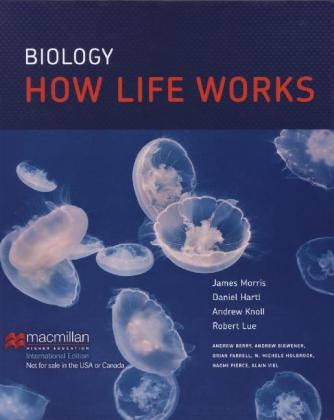Partager
Daniel L. Hartl, Andrew H. Knoll, James R. Morris, Alain Viel
Biology: How Life Works
Anglais · Livre Relié
Description
Biology: How Life Works is the first project to develop three pillars-the text, the visual program, and the assessment-at the same time. All three pillars were developed in parallel to make sure that each idea is addressed in the most appropriate medium, and to ensure authentic integration. These three pillars are all tied to the same set of core concepts, share a common language, and use the same visual palette. In this way, the text, visual program, and assessments are integral parts of student learning, rather than just accessories to the text. This multi-media pack contains the print textbook and LaunchPad access for an additional Pds. 5 per student.
LaunchPad is an interactive online resource that helps students achieve better results. LaunchPad combines an interactive e-book with high-quality multimedia content and ready-made assessment options, including LearningCurve, our adaptive quizzing resource, to engage your students and develop their understanding.
Features include:
- Pre-built Units for each chapter, curated by experienced educators, with media for that chapter organized and ready to assign or customize to suit your course.
- Intuitive and useful analytics, with a Gradebook that lets you see how your class is doing individually and as a whole.
- A streamlined and intuitive interface that lets you build an entire course in minutes.
LearningCurve in Launchpad
In a game-like format, LearningCurve adaptive and formative quizzing provides an effective way to get students involved in the coursework. It offers:
- A unique learning path for each student, with quizzes shaped by each individual's correct and incorrect answers.
- A Personalised Study Plan, to guide students' preparation for class and for exams.
- Feedback for each question with live links to relevant e-book pages, guiding students to the reading they need to do to improve their areas of weakness.
For more information on LaunchPad including how to request a demo, access our support centre, and watch our video tutorials, please visit here.
Request a demo
Table des matières
1. Life: Chemical, Cellular, and Evolutionary Foundations.- Case 1 The First Cell: Life's Origins.- 2. The Molecules of Life.- 3. Nucleic Acids and the Encoding of Biological Information.- 4. Translation and Protein Structure.- 5. Organizing Principles: Lipids, Membranes and Cell Compartments.- 6. Making Life Work: Capturing and Using Energy.- 7. Cellular Respiration: Harvesting Energy from Carbohydrates and Other Fuel Molecules.- 8. Photosynthesis: Using Sunlight to Build Carbohydrates.- Case 2 Cancer: When Good Cells Go Bad.- 9. Cell Communication.- 10. Cell Form and Function: Cytoskeleton, Cellular Junctions, and Extracellular Matrix.- 11. Cell Division: Variations, Regulation, and Cancer.- Case 3 You, from A to T: Your Personal Genome.- 12. DNA Replication and Manipulation.- 13. Genomes.- 14. Mutation and DNA Repair.- 15. Genetic Variation.- 16. Mendelian Inheritance.- 17. Beyond Mendel: Sex Chromosomes, Linkage, and Organelles.- 18. The Genetic and Environmental Basis of Complex Traits.- 19. Genetic and Epigenetic Regulation.- 20. Genes and Development.- Case 4 Malaria: Coevolution of Human and a Parasite.- 21. Evolution: How Genotypes and Phenotypes Change Over Time.- 22. Species and Speciation.- 23. Evolutionary Patterns: Phylogeny and Fossils.- 24. Human Origins and Evolution.- 25. Cycling Carbon.- Case 5 The Human Microbiome: Diversity Within.- 26. Bacteria and Archaea.- 27. Eukaryotic Cells: Origins and Diversity.- 28. Being Multicellular.- Case 6 Agriculture: Feeding a Growing Population.- 29. Plant Structure and Function: Moving Photosynthesis onto Land.- 30. Plant Reproduction: Finding Mates and Dispersing Young.- 31. Plant Growth and Development: Building the Plant Body.- 32. Plant Defense: Keeping with World Green.- 33. Plant Diversity.- 34. Fungi: Structure, Function, and Diversity.- Case 7 Predator-Prey: A Game of Life and Death.- 35. Animal Nervous Systems.- 36. Animal Sensory Systems and Brain Function.- 37. Animal Movement: Muscles and Skeletons.- 38. Animal Endocrine Systems.- 39. Animal Cardiovascular and Respiratory Systems.- 40. Animal Metabolism, Nutrition, and Digestion.- 41. Animal Renal Systems: Water and Waste.- 42. Animal Reproduction and Development.- 43. Animal Immune Systems.- Case 8 Biodiversity Hotspots: Rainforests and Coral Reefs.- 44. Animal Diversity.- 45. Animal Behavior.- 46. Population Ecology.- 47. Species Interactions, Communities, and Ecosystems.- 48. The Anthropocene: Humans as a Planetary Force.
A propos de l'auteur
James R. Morris, Daniel L. Hartl, Andrew H. Knoll, Robert A. Lue, Andrew Berry, Andrew Biewener, Brian Farrell, Noel Michele Holbrook, Naomi Pierce and Alain Viel
Détails du produit
| Auteurs | Daniel L. Hartl, Andrew H. Knoll, James R. Morris, Alain Viel |
| Edition | Macmillan Education |
| Langues | Anglais |
| Format d'édition | Livre Relié |
| Sortie | 03.09.2013 |
| EAN | 9781464156014 |
| ISBN | 978-1-4641-5601-4 |
| Pages | 1200 |
| Dimensions | 234 mm x 284 mm x 43 mm |
| Poids | 2574 g |
| Thème |
W. H. Freeman |
| Catégorie |
Sciences naturelles, médecine, informatique, technique
> Biologie
|
Commentaires des clients
Aucune analyse n'a été rédigée sur cet article pour le moment. Sois le premier à donner ton avis et aide les autres utilisateurs à prendre leur décision d'achat.
Écris un commentaire
Super ou nul ? Donne ton propre avis.

